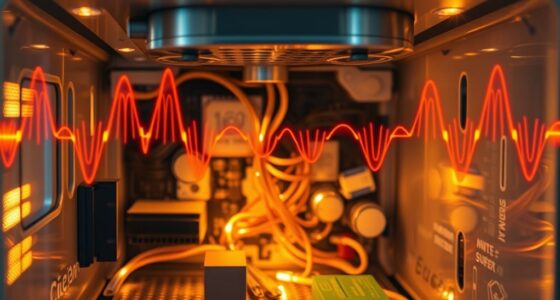We have conducted research and identified the appliances that will have the biggest impact on your wallet.
From refrigerators to air conditioners, electric water heaters to clothes dryers, these power-hungry devices can quickly rack up your energy bill.
In this article, we’ll break down the top culprits for high energy consumption in your home.
So, if you’re aiming for mastery over your expenses, stay tuned to discover which appliances are the most expensive to run.

Key Takeaways
- Refrigerators account for about 13% of a household’s total energy consumption.
- Older models of refrigerators tend to consume more energy compared to newer, Energy Star-rated models.
- Air conditioners consume a significant amount of energy.
- Electric water heaters have varying costs based on their energy efficiency ratings.
Refrigerators
Refrigerators consume a significant amount of energy, making them one of the most expensive appliances to run. On average, refrigerators account for about 13% of a household’s total energy consumption. The energy usage varies depending on factors such as size, age, and efficiency rating. Older models tend to consume more energy compared to newer, Energy Star-rated models.
Regular maintenance plays a crucial role in reducing energy consumption and prolonging the lifespan of a refrigerator. Simple tasks like cleaning the coils, checking the door seals, and defrosting can help optimize its energy efficiency. Additionally, the maintenance cost of refrigerators can include repairs, replacing worn-out parts, and periodic servicing.
By being mindful of energy consumption and prioritizing maintenance, homeowners can effectively manage the costs associated with running a refrigerator.
Transitioning to the subsequent section about ‘air conditioners’, it’s important to note that these appliances also consume a considerable amount of energy.

Air Conditioners
Air conditioners also consume a significant amount of energy, making them another one of the most expensive appliances to run. To minimize the costs associated with running an air conditioner, there are several energy-saving tips you can follow.
First, ensure that your air conditioner is properly sized for the space it’s cooling, as an oversized unit will use more energy.
Additionally, regularly clean or replace air filters to maintain efficient airflow. Proper insulation and sealing of windows and doors can also help reduce energy consumption.
Lastly, consider using a programmable thermostat to adjust the temperature when you aren’t at home.

It’s important to note that the maintenance costs of air conditioners can also add up over time. Regularly servicing your unit and addressing any issues promptly can help prevent more expensive repairs in the future.
Electric Water Heaters
When it comes to electric water heaters, there are several important points to consider.
Firstly, the cost comparisons of different heaters can vary significantly, with some models being more expensive to run than others.
Secondly, energy efficiency ratings play a crucial role in determining the long-term costs of operating an electric water heater.

Lastly, it’s important to keep in mind the potential for long-term savings when choosing an electric water heater that’s both cost-effective and energy efficient.
Cost Comparisons of Heaters
Electric water heaters can be costly to run, especially during peak usage times. When comparing the cost of different heaters, it’s important to consider their energy consumption. Here are some important cost comparisons to keep in mind:
- Tankless Electric Water Heaters:
- These heaters are more energy-efficient than traditional tank heaters, as they only heat water when it’s needed.
- They can be more expensive upfront, but their lower energy consumption can result in long-term savings.
- The cost of running a tankless electric water heater depends on factors such as the size of the unit and the frequency of hot water usage.
- Electric Heat Pump Water Heaters:
- These heaters use electricity to move heat from the air or ground to heat the water.
- They’re more energy-efficient than standard electric water heaters, resulting in lower energy costs.
- However, they may have a higher upfront cost compared to traditional heaters.
- Traditional Electric Water Heaters:
- These heaters have a storage tank that constantly keeps water heated.
- They tend to have higher energy consumption and can be costly to run, especially during peak usage times.
- The cost of operating a traditional electric water heater depends on factors such as the tank size and insulation.
Energy Efficiency Ratings
We evaluated the energy efficiency ratings of electric water heaters to determine their cost-effectiveness. Energy efficiency benefits are important because they can significantly reduce energy consumption and lower electricity bills.
When it comes to electric water heaters, the higher the energy efficiency rating, the more cost-effective they’re in the long run. Electric water heaters with higher ratings use less energy to heat the water, which means less energy is wasted and more money is saved.

Long-Term Savings Potential
To maximize our long-term savings potential with electric water heaters, we should prioritize energy efficiency ratings.
Here are three energy saving strategies that can lead to long term financial benefits:
- Insulate your water heater: Adding insulation to your electric water heater can reduce heat loss, saving you money on energy bills.
- Lower the thermostat temperature: Lowering the temperature on your water heater can significantly reduce energy consumption. For every 10 degrees Fahrenheit reduction, you can save up to 5% on your water heating costs.
- Install a timer: By using a timer, you can schedule your electric water heater to turn off during times when hot water isn’t needed, such as when you’re away or asleep. This can lead to substantial energy savings over time.
Clothes Dryers
Using clothes dryers frequently can significantly increase our utility bills. However, there are cost-saving maintenance tips and energy-efficient drying options that can help mitigate the expenses.
To start, regular maintenance, such as cleaning the lint trap and vent, can improve the dryer’s efficiency and prevent potential fire hazards. Additionally, opting for a dryer with a moisture sensor can ensure that clothes are dried efficiently without over-drying, saving both energy and money.

Another energy-saving option is to air dry clothes whenever possible, especially during warmer months. By utilizing these cost-saving maintenance tips and energy-efficient drying options, we can reduce our utility bills while still enjoying the convenience of a clothes dryer.
Now, let’s transition to the subsequent section about electric ovens.
Electric Ovens
When it comes to electric ovens, there are a few key points to consider.
First, it’s important to explore energy-efficient oven options that can help reduce your energy consumption.

Second, implementing cost-saving cooking tips, such as using the oven for multiple dishes at once or utilizing residual heat, can also make a difference.
Lastly, comparing oven power consumption can help you choose a model that’s more energy-efficient and cost-effective in the long run.
Energy-Efficient Oven Options
We found that our energy-efficient oven options for electric ovens were surprisingly cost-effective. These energy-efficient oven models offer several benefits, including:
- Convection technology: Energy-efficient electric ovens often come equipped with convection technology. This feature uses a fan to circulate hot air evenly throughout the oven, resulting in faster cooking times and more efficient heat distribution. This can help reduce energy consumption and save you money on your electricity bills.
- Precise temperature control: Energy-efficient electric ovens typically have advanced temperature control features. This allows you to set and maintain precise temperatures, ensuring that your food is cooked evenly and efficiently. By avoiding unnecessary temperature fluctuations, these ovens can help save energy and reduce cooking times.
- Insulation: Energy-efficient electric ovens are often built with high-quality insulation materials. This helps to retain heat and prevent energy wastage. The improved insulation can also contribute to a more consistent cooking experience, as it reduces the chances of hot or cold spots in the oven cavity.
Investing in an energy-efficient electric oven can’t only save you money on your energy bills but also provide you with superior cooking performance. Consider these options when looking for a cost-effective and efficient oven for your kitchen.

Cost-Saving Cooking Tips
To continue our discussion on energy-efficient electric ovens, let’s explore some cost-saving cooking tips.
One way to save money while cooking is to practice cost-saving grocery shopping. Plan your meals in advance and create a shopping list based on the ingredients you need. This will help you avoid impulse purchases and reduce food waste. Additionally, consider purchasing in bulk or buying seasonal produce, as they tend to be more affordable.
Another way to save on energy costs is by using energy-saving lighting options in your kitchen. Replace traditional incandescent bulbs with LED or CFL bulbs, which use less energy and last longer.
Comparing Oven Power Consumption
How much electricity do electric ovens consume? When comparing oven power consumption, it’s important to consider energy-efficient oven options.

Here are some cost-saving cooking tips to help you make an informed decision:
- Look for ovens with an Energy Star rating, which indicates higher energy efficiency.
- Opt for convection ovens that use fans to circulate hot air, reducing cooking time and energy consumption.
- Consider self-cleaning ovens with an energy-saving mode that uses less power during the cleaning process.
Dishwashers
What are the factors that contribute to the high energy consumption of dishwashers?
Dishwashers consume a significant amount of energy due to several factors. Firstly, older models tend to be less energy-efficient compared to newer ones. Regular dishwasher maintenance can help improve its efficiency by ensuring that all parts are functioning optimally.
Secondly, the water temperature used during the wash cycle greatly affects energy consumption. Higher water temperatures require more energy to heat the water.

Thirdly, the duration of the wash cycle also plays a role. Longer cycles result in higher energy consumption.
To address these concerns, eco-friendly dishwasher options are now available in the market. These models are designed to use less water and energy without compromising cleaning performance.
Desktop Computers
We can also consider desktop computers when discussing the appliances that are most expensive to run. Desktop computers are notorious for their high energy consumption and power usage. Here are three factors that contribute to their expensive operation:
- Processor: The processor is the brain of the computer and requires a significant amount of electricity to perform calculations and execute tasks efficiently. More powerful processors consume more energy, leading to higher power usage.
- Graphics card: Desktop computers often have dedicated graphics cards to handle demanding graphics-intensive tasks. These cards consume a substantial amount of power, especially when running graphics-intensive applications or playing games.
- Peripherals: Desktop computers are typically connected to multiple peripherals such as monitors, printers, and external hard drives. These peripherals consume additional power, contributing to the overall energy consumption of the desktop computer.
Considering these factors, it’s crucial to be mindful of energy-efficient desktop computer components and optimize power settings to minimize electricity usage and save on energy costs.

Plasma/Lcd Televisions
When it comes to Plasma/LCD televisions, there are a few key points to consider.
Firstly, there are energy-efficient alternatives available on the market that can help reduce electricity costs.
Secondly, it’s important to implement cost-saving measures, such as adjusting the brightness and using power-saving modes when the television isn’t in use.
Energy-Efficient Alternatives Available
Energy-efficient alternatives such as plasma and LCD televisions can significantly reduce the cost of running these appliances. By choosing these energy-saving options, you can enjoy the benefits of energy-efficient appliances while also saving money on your electricity bills.

Here are some energy-saving tips to consider when it comes to plasma and LCD televisions:
- Choose an ENERGY STAR certified model: These televisions meet strict energy efficiency guidelines, ensuring that they consume less power while providing high-quality performance.
- Adjust the brightness settings: Lowering the brightness level can reduce energy consumption without compromising the viewing experience.
- Enable power-saving features: Many plasma and LCD televisions come with power-saving options such as automatic standby or sleep mode, which help reduce energy usage when the TV isn’t in use.
Cost-Saving Measures Recommended
To save on energy costs with plasma and LCD televisions, consider implementing cost-saving measures such as adjusting brightness settings and enabling power-saving features. By reducing the brightness level, you can significantly decrease the amount of energy consumed by your television. Additionally, enabling power-saving features, such as automatic standby mode or sleep mode, can further reduce electricity usage when the TV is not in use. To help you visualize the potential savings, here is a table highlighting the estimated energy consumption and cost for a plasma and LCD television:
| Plasma Television | LCD Television | |
|---|---|---|
| Energy Consumption (Wattage) | 300 | 150 |
| Annual Electricity Cost (at $0.12/kWh) | $263.04 | $131.52 |
Washing Machines
Washing machines can be costly to operate. However, there are energy saving features and water consumption efficiency measures that can help reduce the financial burden. Here are three ways to make your washing machine more cost-effective:
- Look for energy-saving features: Many modern washing machines come with features like load sensing technology and adjustable water temperature settings. These features optimize energy usage and reduce water consumption, resulting in lower operating costs.
- Opt for front-loading machines: Front-loading washing machines are generally more energy efficient than top-loading ones. They use less water and require less electricity to run, making them a cost-effective choice in the long run.
- Use full loads and proper settings: Running your washing machine with full loads maximizes its efficiency and reduces the number of cycles needed. Also, using the appropriate settings for each load, such as shorter wash cycles and lower water temperatures, can help save energy.
With these energy-saving measures and water consumption efficiency tips, you can minimize the operating costs of your washing machine.

Now let’s transition to the next topic: electric stoves.
Electric Stoves
Now let’s talk about electric stoves and how they can impact our energy usage and operating costs.
When it comes to cooking, electric stoves are known for their efficiency and reliability. However, they can also be costly to run, especially if used frequently.
To save on energy costs, consider these cost-saving cooking tips:

- Use the right size burner for your cookware.
- Keep lids on pots to retain heat.
- Use residual heat to complete cooking.
Additionally, investing in energy-efficient oven options can help reduce operating costs. Look for stoves with features like insulation, convection fans, and precise temperature controls. These features not only save energy but also ensure optimal cooking results.
Pool Pumps
After discussing the impact of electric stoves on energy usage and operating costs, let’s now turn our attention to pool pumps and how they can affect our expenses.
Pool pumps are essential for maintaining the cleanliness and circulation of the water in our pools. However, they can consume a significant amount of energy if not properly maintained and used efficiently.
To help you save on energy costs, here are some pool pump energy saving tips:

- Regular pool pump maintenance:
- Clean the pump basket and filter regularly to ensure optimal performance and prevent clogs.
- Check for leaks and repair them promptly to avoid wasting energy.
- Optimize pump usage:
- Run the pump for shorter periods during off-peak hours when electricity rates are lower.
- Use a pool cover to reduce evaporation and decrease the need for pump operation.
- Upgrade to a variable speed pump:
- Variable speed pumps allow you to adjust the speed based on your pool’s needs, saving energy and money in the process.
Space Heaters
Space heaters can significantly impact our energy usage and operating costs. These heating devices consume a considerable amount of electricity, making them expensive to run. However, there are cost-saving measures and energy-efficient alternatives available to mitigate these expenses.
To reduce the energy consumption of space heaters, one option is to invest in models with programmable thermostats and timers. These features allow you to set specific temperatures and operating times, ensuring that the heater runs only when needed. Additionally, using space heaters in conjunction with proper insulation and weather-stripping can help retain heat, reducing the need for excessive heating.
Energy-efficient alternatives to space heaters include using electric blankets or heated mattress pads, which consume less energy and provide localized warmth. Another option is to install a zoned heating system, which allows you to heat specific areas of your home as needed, reducing overall energy consumption.
Frequently Asked Questions
Are There Any Energy-Saving Options Available for Refrigerators?
There are energy-saving options available for refrigerators, such as energy-saving technologies and energy-efficient home appliances. These options can help reduce energy consumption and lower electricity bills.

How Can I Determine the Energy Efficiency of an Air Conditioner?
To determine an air conditioner’s energy efficiency, we can assess its SEER rating, which measures cooling output relative to energy input. Regular air conditioner maintenance can also optimize its efficiency. Additionally, consider energy-efficient air conditioner options for long-term savings.
What Is the Average Lifespan of an Electric Water Heater?
The average lifespan of an electric water heater is around 10-15 years. However, upgrading to a more energy-efficient model can provide long-term benefits such as lower average cost and reduced environmental impact.
Can Using a Clothes Dryer Less Frequently Help Save on Electricity Costs?
Using a clothes dryer less frequently can indeed help save on electricity costs. Air drying clothes has a significant impact on reducing electricity consumption. Benefits of using a clothesline include lower energy bills and increased sustainability.
Are There Any Maintenance Tasks That Can Improve the Energy Efficiency of an Electric Oven?
Performing regular maintenance tasks can greatly improve the energy efficiency of an electric oven. Simple tasks like cleaning the oven and its components, checking for leaks, and replacing worn-out parts can make a significant difference in reducing energy consumption.

Conclusion
Based on data-driven research, it’s clear that certain appliances consume a significant amount of energy, making them costly to run.
Take refrigerators, for example, which can be compared to an insatiable beast constantly devouring electricity, as they work tirelessly to keep our food fresh.
Similarly, air conditioners can be seen as the cool oasis in the scorching desert of summer, but they come at a price.
By being aware of the energy consumption of these appliances, we can make informed choices to save both energy and money.











